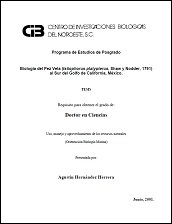Morphophysiological Indices of the Green Abalone Haliotis fulgens Philippi, 1845 at Mexican Ocean Pacific Coast
Autor
MONICA NURENSKAYA VELEZ ARELLANO
FEDERICO ANDRES GARCIA DOMINGUEZ
DANIEL BERNARDO LLUCH COTA
JOSE LUIS GUTIERREZ GONZALEZ
LUIS ANTONIO SALCIDO GUEVARA
REBECA SANCHEZ CARDENAS
Metadatos
Mostrar el registro completo del ítemResumen
"The monitoring on abalone banks has been intensified since the declining of wild global production due to overfishing, disease, environmental changes and poaching. This is to support timely decisions to execute actions for mitigation, prevention, conservation and fisheries production benefits. Eight morphophysiological indices for green abalone, Haliotis fulgens Philippi, 1845 from the Pacific coast of Mexico were evaluated and their performance were elucidated due to their potential as monitoring tools. The Boolootian’s gonadic index (GIB) and gonadic area index (GAIA) were informative ofcomplete reproductive cycle, thus are reliable for reproductive patterns monitoring. While gonadic index (GI) and gonadic index of calculated mass (MGI) were suitable indicators only of spawning. The condition index of calculated mass (MCI), foot index of calculated mass (MFI), condition index (CI) and foot index (FI) proved temporal changes of soft tissues condition. The MFI clearly defined the best nutritional status of the green abalone foot between March to August, indicating the time when fishing organizations can get the best yields and highest foot quality at Baja California Peninsula, Mexico. Therefore MFI can be used as cheap and quick information to make decisions on the start-up of fishing operations and abalone condition monitoring."
Colecciones
Ítems relacionados
Mostrando ítems relacionados por Título, autor o materia.
-
PROMOCIÓN DEL PERIFITON PARA EL CULTIVO DE CAMARÓN BLANCO: HACIA UNA ACUICULTURA ECOLÓGICA
DOMENICO VOLTOLINA LOBINA; JUAN MANUEL AUDELO NARANJO; MARIA DEL ROSARIO PACHECO MARGES -
Suelo y Erosión
YOLANDA LOURDES MAYA DELGADO


